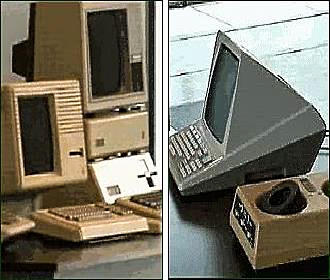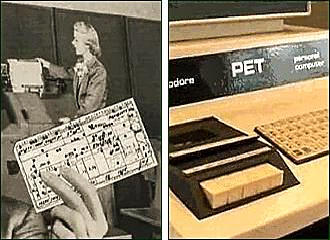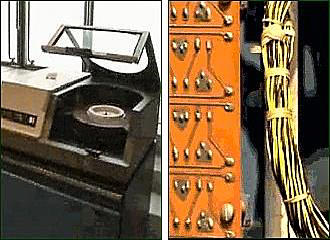This location is now closed.
The following article is left as-is for historical and archiving purposes.
Musee de l’Informatique in Paris
From when the Defense area of Paris first started to get developed, some of the most major IT companies set up their offices here and there is also the large CNIT exhibition centre that plays host to major exhibitions, and when the Grande Arche was built in this district, it provided a hub for international communications. CLOSED
So, within the modern building, that already has its roots well within the history of Paris, it is fitting and very apt to have the Musee de l’Informatique or Computer Museum in Paris housed within the roof part of the Grande Arche, and this is the very first French museum dedicated to computing technology.
A bit of computing history
Even though communications were already in place for the military, like the tests and communications that were conducted at the Eiffel Tower, which then led to helping allied forces during World War I, it was only World War II that became classified as the very first high tech war.
Many people have the visions that computers were extremely large in the early days and could take up whole rooms, and this is definitely true, and it was during World War II that we saw the release of Colossus, which we think the name says it all! And this was the very first entirely electronic computer that helped the Allies obtain victory by decrypting more than 80,000 German messages.
Now, when we talk of large computers, it was in 1945 that an American army computer scientist by the name of Grace Hopper, discovered a bug in the computer, which was called the ENIAC and it provoked a short circuit. Now this computer had 17,468 tubes and 70,000 resisters and each one had to be checked, and after a few thousand resisters later, they eventually they found a moth that had managed to get inside, which is where the term a computer bug first came from!
Then in 1965 a black and red computer by Honeywell was designed with a built in chopping board that was meant to propose different recipes, and yet astoundingly even this computer still weighed around 68kg.
Now before 1970, data was mainly held on large magnetic tapes or the very limited hard drives of the computers themselves, but in 1971, it was IBM that pioneered the floppy drive that allowed the storage of more than 128,000 characters on one disc, that was around 20cm in size, but as time went on, these got progressively smaller and allowed for larger data limits. Yet these eventually got replaced by CD Roms, then by USB dongles.
However, it was not until 1981 that the most famous of all the personal computers was launched by IBM, but many computer scientists rejected this concept, believing that it would mean the disappearance of their power, plus there were many executives that were opposed to the computer, feeling that the keyboard should be kept as the job for a secretary and not something they should use.
And even though the cost of this personal computer was almost €7,000 when it was released within the French market, and with the negative attitudes of many, it still became a resounding success and was the benchmark of future computer technology within the home and workplace that we all now take for granted.
Of course video games were also around at this time and the first true game for the PC was Tetrus that was invented in 1985, however, we will mention all about video games within the article on the video game museum called the Musee du Jeu Video that is also housed in the Grande Arche Monument in Paris.
But taking a step back in time again, there was something called the ArpaNet Network that was developed in 1969, which was first used by American universities and research centres for sending messages and transferring files back and forth.
Yet it was not until the year 1990, that Tim Berners-Lee invented the World Wide Web, which enabled the general public to take advantage of messaging, information and communication with other individuals, rather than it being restricted to government and institutions such as universities.
About the Musee de l’Informatique
The whole concept of this museum was born from the observations that even though the computer is in our present time, it already has roots back in history and technology is ever developing for these to continue in ways that we may not think possible for the future.
And, how the world has changed with the invention of computers, the thought was to preserve this for generations to come, so that they can understand how things started and also gain an awareness of progress, power and speed, along with the continuous progress that we are already experiencing today.
So, the true mission and goal of the Computer Museum, is to let people know the past, understand the present, and hopefully fuel the imagination of generations for what the computing technology could be in the future.
Spread over an area of around 100m long the Musee d l’Informatique provides displays of many different types of early computer through to present day and beyond, plus there are also temporary exhibitions that provide an insight into more recent discoveries and innovations along with projections of what technology is likely to advance to in the future.
There is always the permanent exhibition space that provides the history of computing along with themed exhibits where you can learn and dream of what might be, and open to everyone of all ages, the computer museum is actually unique within the whole of Europe.
And yet there is so much more to the Grande Arche, like the different galleries, the more recent video game museum and much more, which means that when you decide to visit the Grande Arche whilst you are on holiday in Paris, your visit will be full of surprises and discovery, including the monuments architecture along with the history of the Grande Arche as well.
Visiting the Musee de l’Informatique
The Grande Arche is open seven days a week, and from the start of September to the end of March is open from 10am through to 7pm. However, from the start of April to the end of August it opens at 10am through to 8pm.
Individuals are a cost of €10 for adults and €8.50 for children, but there are discounts for groups upon reservation and for this cost you can get to experience the Computer Museum along with all the other displays and galleries.
The Grand Arche is easily accessible via Paris Metro with direct access from the Chatelet station in around 10 minutes and this is via line 1. The RER on line A is another option, as is the Tramway T2.


